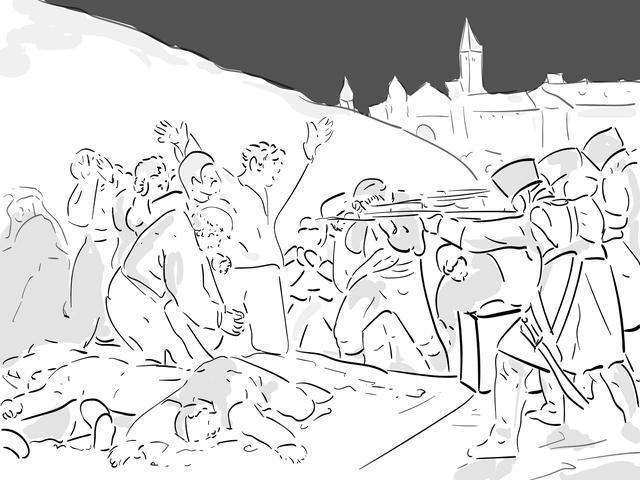On May 3 in Madrid

The Third of May in Madrid, also known as The Executions on the Mountain of Príncipe Pío or The Executions of the Third of May, is a renowned painting by the Aragonese artist Francisco de Goya, completed in 1814. This masterpiece is a powerful depiction of the Spanish people's resistance against French occupation during the May 2 uprising at the onset of the Spanish War of Independence. Alongside its companion piece, The Second of May 1808 in Madrid, also known as The Burden of the Mamelukes, these paintings capture the tumultuous events of the time with Goya's signature technique and vivid chromaticism.
Goya's motivation for creating these monumental works was to immortalize the heroic actions and scenes of the Spanish insurrection against tyranny. The Third of May 1808 stands out for its dark and intense imagery, evoking a sense of horror that was groundbreaking in Spanish art. The painting has served as a source of inspiration for numerous artists, including Édouard Manet and Pablo Picasso, whose works such as The Execution of Maximilian and Guernica bear the influence of Goya's powerful portrayal of war and resistance.
Despite initial skepticism about the painting's attribution to Goya by José de Madrazo in the 1850s, The Third of May 1808 gained international acclaim in later years as a precursor to Impressionism and Romanticism. The work's significance led to its relocation to Valencia during the Spanish Civil War to protect it from potential damage, although it did suffer some harm during the transfer. Thanks to meticulous restoration efforts in subsequent years, including in 1938, 1939, 1941, and 2008, the painting has been preserved for future generations to appreciate and reflect upon.
The Third of May in Madrid continues to captivate viewers with its raw emotion, stark imagery, and historical significance. As a pivotal piece in Goya's oeuvre and in the canon of Spanish art, this painting serves as a poignant reminder of the enduring human spirit in the face of oppression and injustice. Visitors to museums such as the Prado in Madrid have the opportunity to witness this iconic work firsthand and immerse themselves in the turbulent events of the Spanish War of Independence through Goya's masterful brushstrokes and evocative storytelling.
© ChatGPT 3.5
The transfer of the works contained in the Prado art gallery, to avoid possible damage, during the bombings of Madrid that occurred from the end of August 1936 to January 1937, is what Picasso represents in Guernica, in the opinion of A. Visedo. The art gallery is the wounded mare. Its content is symbolized by a small Pegasus (winged horse from Greek mythology) that emerges from the mare's belly in the preparatory sketches made since May 1, 1937. This Pegasus had already been used to represent Art in the vignettes. from his etching “Dream and lie of Franco”. Finally, and continuing with Greek mythology, he transforms the horse into a Constellation (the sun with a light bulb) just as Zeus did as a reward for his services, turning him from mortal into immortal; This is how Picasso ensures that Art does not die. “My whole life has been a fight to keep Art alive”